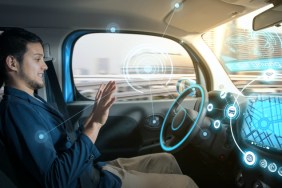Nvidia is diving into the autonomous car game with gusto, handing over new processors to major car manufacturers such as Tesla Motors, Aston Martin, Bentley and Rolls Royce in order to help their automobiles “see.”
Nvidia is most famous for making powerful GPUs for gaming PCs and consoles, though it is making big strides in the self-driving car space by attempting to introduce autonomous capabilities to cars that look more aesthetically pleasing than the Google Car. “Nobody wants to buy a car with a trunk full of PCs or something spinning on top of it,” said Danny Shapiro, Nvidia’s senior director of automotive operations. “You want it to look like a normal car.”
The company’s vision for a future in the burgeoning self-driving car market has therefore led them to create the new kit, which combines an on-board graphics processor boasting image recognition software with the power of large-scale servers based in each carmaker’s autonomous testing labs, that allow the vehicles to make intelligent decisions whilst driving.
Also See: Tidal Shows it’s Not Elitist with a Video of Beyonce Pouring Champagne into a Hot Tub
It is expected that this tech will eventually enable them to avoid objects on the road, along with braking and swerving in times of emergency. It’ll work by the graphics processor analyzing the video input from the image recognition software in order to determine corners and edges in the vehicle’s surroundings, looking for identifiable patterns that it can use in order to create a clear depiction of the world around the car.

Nvidia wants the vehicles carrying its autonomous tech to be more aesthetically appealing than the Google Car. (Getty Images)
This data can be used by the car to determine nearby pedestrians, turnings in roads, parked cars and more, with it also being able to differentiate between different types of vehicles, such as acknowledging police vehicles in order to inform the driver to pull over if they’re being flashed. It also uses a form of artificial intelligence in order to “learn” and adapt to events and situations it may not have necessarily seen before, therefore allowing it to administer the appropriate response if such as event arises again.
Though the hardware is not yet being sold to the general public, it is believed that within two years it will be running as Nvidia intended it, therefore meaning that it should receive a consumer release at some point in the near future. It’s clear that Nvidia is opting for a different route to Google in the self-driving car market, who are putting their full weight behind autonomous tech by developing a vehicle that requires no input from its passengers, providing a meeting point between the two that will see the development of more intelligent vehicles that still rely upon the skills of their drivers, rather than vehicles that essentially demote them to backseat passengers. As such, it could prove to be incredibly lucrative for Nvidia and the manufacturers that are benefiting from the company’s autonomous tech.
(Via Wall Street Journal)




